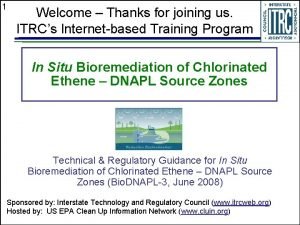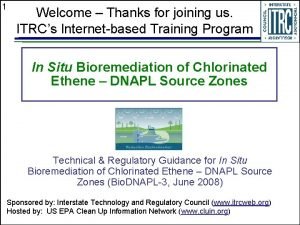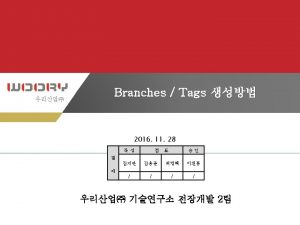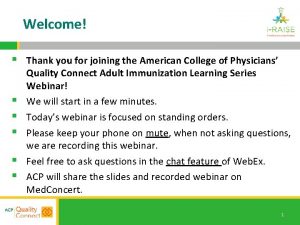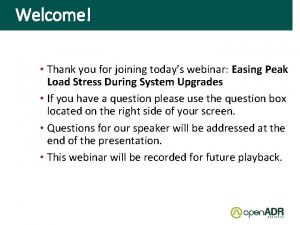Welcome Thank you for joining the American College























































![Outpatient Results § Influenza • 4331 doses dispensed [8/1/15 – 11/10/15] • 2014: 4830 Outpatient Results § Influenza • 4331 doses dispensed [8/1/15 – 11/10/15] • 2014: 4830](https://slidetodoc.com/presentation_image/54bacdb202767db4995a521bdfef0289/image-56.jpg)

- Slides: 57

Welcome! § Thank you for joining the American College of Physicians’ § § § Quality Connect Adult Immunization Learning Series Webinar! We will start in a few minutes. Today’s webinar is focused on standing orders. Please keep your phone on mute, when not asking questions, we are recording this webinar. Feel free to ask questions in the chat feature of Web. Ex. ACP will share the slides and recorded webinar on Med. Concert. 1

Today’s Speakers § Dr. Robert H. Hopkins, Jr. , MD, FACP § Internal Medicine Division Director, from the University of Arkansas for Medical Sciences § L. J. Tan, Ph. D § Chief Strategy Officer at the Immunization Action Coalition and is Co-Chair, National Adult and Influenza Immunization Summit 2

Standing Orders – A Model to Fit Your Practice Robert Hopkins Jr. MD, FACP LJ Tan, Ph. D November 20, 2015 Adult Immunization Learning Series Webinar 3

Standing Orders: An Overview LJ Tan, Ph. D 4

Outline § What are standing orders? § What are the components of a standing orders protocol? § Do standing orders improve vaccination rates? § How do standing orders benefit medical practices? 5

The Problem § Adult immunization rates are appallingly low § Patients aren’t receiving their recommended vaccinations during office visits § Clinicians must address acute and chronic medical issues first; results in lack time for vaccinations and other preventive health issues § Missed immunization opportunities abound § Patients are not protected from vaccine-preventable diseases 6

Standing Orders – A Solution The goal of using standing orders is to increase vaccination coverage by: § Reducing missed opportunities in your practice § Routinizing vaccination by making it a program rather than relying on an individual clinician’s order for each dose of vaccine § Empowering nurses (or other legally qualified individuals) to manage your vaccination program § Freeing up clinician time 7

What are standing orders? 8

Standing Orders – What Are They? § Written protocols, approved by a physician or other authorized practitioner, that authorize nurses, pharmacists, or other healthcare personnel (where allowed by state law) to: • Assess a patient’s need for vaccination • Administer the vaccine without a clinician’s direct involvement with the individual patient at the time of the interaction 9

Who Recommends Use of Standing Orders? § The Community Preventive Services Task Force recommends standing orders to increase vaccination coverage among adults and children on the basis of strong evidence of effectiveness. § Applicable to patients in both inpatient and outpatient settings where improvements in coverage are needed. § The Advisory Committee on Immunization Practices (ACIP) recommends standing orders for influenza, pneumococcal vaccinations, and several other adult vaccines. 10

11

12

Use of Standing Orders § In 2009, only 42% of physicians reported using standing orders for adult influenza vaccination § Only 23% reported consistently using standing orders for both influenza vaccine and pneumococcal polysaccharide vaccine Zimmerman et al. Am J Prev Med 2011; 40(2): 144 -8 13

Use of Standing Orders Lack of standing orders implementation may be due to: § Weak or no organizational support § Small size of the clinical support staff relative to providers § Concerns about legal ramifications of standing orders 14

Barriers to the Use of Standing Orders Yonas et al. J Healthcare Quality 2012; 34: 34 -42 15

Vaccine Injury Compensation Program § Established by National Childhood Vaccine Injury Act (1986) § Provides no-fault compensation for specified injuries that are temporally related to specified vaccinations § Program has greatly reduced the risk of litigation for both providers and vaccine manufacturers § Covers all routinely recommended childhood vaccines, including those administered to adults 16

What are the components of a standing orders protocol? 17

18

Components of a Standing Orders Protocol § A comprehensive standing order should include these elements: • Who is targeted to receive the vaccine • How to determine if a patient needs or should receive a • • particular vaccination (e. g. , indications, contraindications, and precautions) Provision of any federally required information (e. g. , Vaccine Information Statement) Procedures for preparing and administering the vaccine (e. g. , vaccine name, schedule for vaccination, appropriate needle size, vaccine dosage, route of administration) 19

Components of a Standing Orders Protocol § A comprehensive standing order should include these elements: • How to document vaccination in the patient record • A protocol for the management of any medical emergency • • related to the administration of the vaccine How to report possible adverse events occurring after vaccination Authorization by a physician or other authorized practitioner 20

Components of a Standing Orders: Protocol (1) § Who is targeted to receive the vaccine – assessing the need 21

Components of a Standing Orders: Protocol (2) § How to determine if the patient can receive a certain vaccination (e. g. , screen for contraindications and precautions) 22

23

Components of a Standing Orders: Protocol (3) § Provision of federally required information: • The Vaccine Information Statement (VIS) 24

25

Components of a Standing Orders: Protocol (4) § Prepare to administer the vaccine (e. g. , by choosing appropriate vaccine product, needle size, and route of administration) 26

Components of a Standing Orders: Protocol (5) § Specific guidance for administration of the vaccine (e. g. , right patient, right vaccine, right age group, right dose, right route, and right site) 27

Components of a Standing Orders: Protocol (6) § How to document vaccination in the patient record 28

29

Components of a Standing Orders: Protocol (7) § A protocol for the management of any medical emergency related to the administration of the vaccine 30

Components of a Standing Orders: Protocol (8) § How to report possible adverse events occurring after vaccination 31

www. vaers. hhs. gov 32

Components of a Standing Orders: Protocol (9) § Authorization: In general, standing orders are approved by an institution, physician, or authorized practitioner. State law or a regulatory agency might authorize other healthcare professionals to sign standing orders 33

Do standing orders improve vaccination rates? 34

Are Standing Orders Effective? § Based on a review of 29 studies (1997 – 2009) that examined standing orders either alone or combined with other activities, the Community Prevention Services Task Force found: • • used alone, standing orders increased adult vaccination coverage by a median of 17 percentage points (range, 13% to 30%) used in combination with other interventions, * standing orders increased adult vaccination coverage by a median of 31 percentage points (range, 13% to 43%) * Such as expanding access in healthcare settings, client reminder and recall systems, clinic-based education, provider reminder and recall systems, or provider assessment plus feedback www. thecommunityguide. org/vaccines/standingorders. html 35

Are Standing Orders Effective? (cont. ) § Based on a review of 29 studies (1997 – 2009) that examined standing orders either alone or combined with other activities, the Community Prevention Services Task Force found: • Standing orders were effective in increasing vaccination • rates when implemented in a range of clinical settings, among various providers and patient populations Standing orders were effective for vaccine delivery to children (universally recommended vaccinations) and adults (influenza and pneumococcal) www. thecommunityguide. org/vaccines/standingorders. htm l 36

Example 1: Use of Standing Orders for Influenza Vaccine in an Ambulatory Care Setting 70 63 60 50 40 38 30 20 10 0 No Standing Order Percentage of Patients Vaccinated With and Without a Standing Order Goebel LJ et al. J Am Geriatr Soc 2005; 53: 1008 -10 37

Example 2: Impact of Standing Orders on Adolescent Vaccination Rates, Denver Health, 2013 38

Standing Orders in Clinical Practice § Efficiency • • Clinician time is not required to assess vaccination needs and issue verbal or written orders to vaccinate Nurses (or others) take charge of vaccination program § Increased number of patients seen = increased income stream § Patient safety • Improved vaccine coverage, less vaccine-preventable disease 39

Summary: Standing Orders Protocols § Standing orders can improve vaccine coverage levels among adults in a variety of settings § Use of standing orders is endorsed by major vaccine policy-making institutions § Standing orders are not difficult to implement but require the “buy in” of everyone in the office § Use of standing orders is facilitated by having an Immunization Champion on the staff 40

Summary: Standing Orders Protocols Take A Stand™: First of its kind national initiative to assist practices to implement vaccination standing orders: www. standingorders. org 41

Standing orders for all routine vaccines are available on the IAC website 42

Resources § Take A Stand™ • www. standingorders. org § Immunization Action Coalition • www. immunize. org § IAC Weekly Updates Via Email • www. immunize. org/subscribe § Standing Orders Protocol Templates • www. immunize. org/standing-orders 43

Standing Orders in Practice: The UAMS Experience Robert Hopkins Jr. MD, FACP 44

University of Arkansas for Medical Sciences (UAMS) § Tertiary Care Referral Center • Inpatient Units • Outpatient Clinics • • On Campus Off Campus • Centers • • • Aging Cancer Spine 45

Standing Orders at UAMS § Have been in place for a variety of uses since 2005 • Immunization [Flu] first used • Pneumococcal developed around 2005 § Broad use of standing orders in Emergency Department, Pre-op, clinics, other settings to improve workflow • Recent CMS guidance that standing orders should not be used except in places where urgent intervention could place patient at risk and immunization • Has led to a great deal of consternation and revision in work flows 46

Current UAMS Vaccine Standing Orders § Influenza § Pneumococcal • PCV 13 • PPSV 23 § Tdap § UAMS Medical Staff By-Laws and Compliance Office • Require annual review/approval of standing orders • Require MD/DO/APN signature [may be post-hoc] § Approval is campus wide • Activation requires medical director sign-off 47

Influenza Standing Orders 48

Standing Orders in Practice § Approved by CMS for Immunization in 2002 § Goal: Improve vaccination rates using whole healthcare team § Challenges come with opportunity • Tradition: Doctor is captain, must steer ship! • Activation/Buy in • Specificity: Simple for Flu, Tdap… more challenging for vaccines • • with specific risk groups Work flow Wrap up 49

Inpatient § Standing orders: Influenza and Pneumococcal § Utilization: Influenza • No 2015 – 16 season rate available • RAW: 403 doses dispensed [data 11/10] • Medicare 2014 – 15 season: 73% Goal: 90% § Utilization: Pneumococcal • No 2015 – 16 season rate available [PM inactive] • RAW: • • PCV 13: PPSV 23: 104 doses dispensed [1/1/15 – 11/10/15] 388 doses dispensed [1/1/15 – 11/10/15] 50

Emergency Department § Standing orders: Tdap § Utilization: • No hard data on which to base assessment • Anecdotes: ‘Routine’ with injury or trauma • RAW: 1247 doses dispensed [1/1/15 – 11/10/15] 51

Outpatient § Standing orders in place: Tdap, Pneumococcal, Influenza • Utilization is variable § Primary Care: Most use • Medical Specialties: Variable Use • Other Specialties: Rarely Use 52

Internal Medicine Experience § Success of standing orders depends on Champion • Higher rates when MD or LPN Champion is on duty • Use in context of a broader Immunization QI plan • May be more controllable and routine in a smaller system or with more ‘closed staff model’ 53

Vaccination Clinics § Standing order is basis for highly-effective annual employee campaign • Mandatory employee flu vaccination since 2012 § [New] Patient-focused vaccine clinic opened 10/1/15 • Primary emphasis: Flu • Secondary emphasis: Pneumococcal • Considering additional vaccines in future iterations 54

Ambulatory Vaccine Clinic 2015 § Co-located with outpatient laboratory • Brief registration • LPN vaccination based on standing orders • [Retroactive] signature by attending MD 55
![Outpatient Results Influenza 4331 doses dispensed 8115 111015 2014 4830 Outpatient Results § Influenza • 4331 doses dispensed [8/1/15 – 11/10/15] • 2014: 4830](https://slidetodoc.com/presentation_image/54bacdb202767db4995a521bdfef0289/image-56.jpg)
Outpatient Results § Influenza • 4331 doses dispensed [8/1/15 – 11/10/15] • 2014: 4830 doses dispensed [8/1/14 – 4/1/2015] § Tdap • 2756 doses dispensed [1/1/15 – 11/10/15] • 1740 doses dispensed in CY 2014 § Pneumococcal • PCV 13 [Prevnar] 3020 doses dispensed [1/1/15 – 11/10/15] • PPSV 23 [Pneumovax] 700 doses dispensed [1/1/15 – 11/10/15] • 2014: PCV 13 = 70; PPSV 23 = 610 56

Discussion and Questions § Questions? § The next Adult Immunization Learning Series Webinar will be in January 2015! • Focused on cultural outreach and communication towards minority and ethnic groups 57
 Welcome and thank you for joining us
Welcome and thank you for joining us Welcome thank you for joining us
Welcome thank you for joining us Thank you for joining our webinar
Thank you for joining our webinar Thank you for joining the webinar
Thank you for joining the webinar Thank you for joining us, good evening
Thank you for joining us, good evening Thank you for joining us, good evening
Thank you for joining us, good evening Thank you for joining us today
Thank you for joining us today Welcome thank you for coming
Welcome thank you for coming Welcome thanks for joining us
Welcome thanks for joining us Olve
Olve Welcome thanks for joining us
Welcome thanks for joining us Thank you for your listening!
Thank you for your listening! Worthy is the lamb thank you for the cross
Worthy is the lamb thank you for the cross Thank you lord for dying on the cross
Thank you lord for dying on the cross Thank you for your attention do you have any questions
Thank you for your attention do you have any questions What colour are reflective studs on left of the carriageway
What colour are reflective studs on left of the carriageway Welcome welcome this is our christmas story
Welcome welcome this is our christmas story Formuö
Formuö Typiska drag för en novell
Typiska drag för en novell Nationell inriktning för artificiell intelligens
Nationell inriktning för artificiell intelligens Ekologiskt fotavtryck
Ekologiskt fotavtryck Varför kallas perioden 1918-1939 för mellankrigstiden?
Varför kallas perioden 1918-1939 för mellankrigstiden? En lathund för arbete med kontinuitetshantering
En lathund för arbete med kontinuitetshantering Adressändring ideell förening
Adressändring ideell förening Tidböcker
Tidböcker Anatomi organ reproduksi
Anatomi organ reproduksi Vad är densitet
Vad är densitet Datorkunskap för nybörjare
Datorkunskap för nybörjare Stig kerman
Stig kerman Debatt mall
Debatt mall Delegerande ledarstil
Delegerande ledarstil Nyckelkompetenser för livslångt lärande
Nyckelkompetenser för livslångt lärande Påbyggnader för flakfordon
Påbyggnader för flakfordon Formel för lufttryck
Formel för lufttryck Publik sektor
Publik sektor Kyssande vind
Kyssande vind Presentera för publik crossboss
Presentera för publik crossboss Teckenspråk minoritetsspråk argument
Teckenspråk minoritetsspråk argument Bat mitza
Bat mitza Klassificeringsstruktur för kommunala verksamheter
Klassificeringsstruktur för kommunala verksamheter Luftstrupen för medicinare
Luftstrupen för medicinare Claes martinsson
Claes martinsson Cks
Cks Verifikationsplan
Verifikationsplan Mat för idrottare
Mat för idrottare Verktyg för automatisering av utbetalningar
Verktyg för automatisering av utbetalningar Rutin för avvikelsehantering
Rutin för avvikelsehantering Smärtskolan kunskap för livet
Smärtskolan kunskap för livet Ministerstyre för och nackdelar
Ministerstyre för och nackdelar Tack för att ni har lyssnat
Tack för att ni har lyssnat Hur ser ett referat ut
Hur ser ett referat ut Redogör för vad psykologi är
Redogör för vad psykologi är Borstål, egenskaper
Borstål, egenskaper Atmosfr
Atmosfr Borra hål för knoppar
Borra hål för knoppar Orubbliga rättigheter
Orubbliga rättigheter Standardavvikelse formel
Standardavvikelse formel Tack för att ni har lyssnat
Tack för att ni har lyssnat









